Lyons W.C. (ed.). Standard handbook of petroleum and natural gas engineering.2001- Volume 1
Подождите немного. Документ загружается.

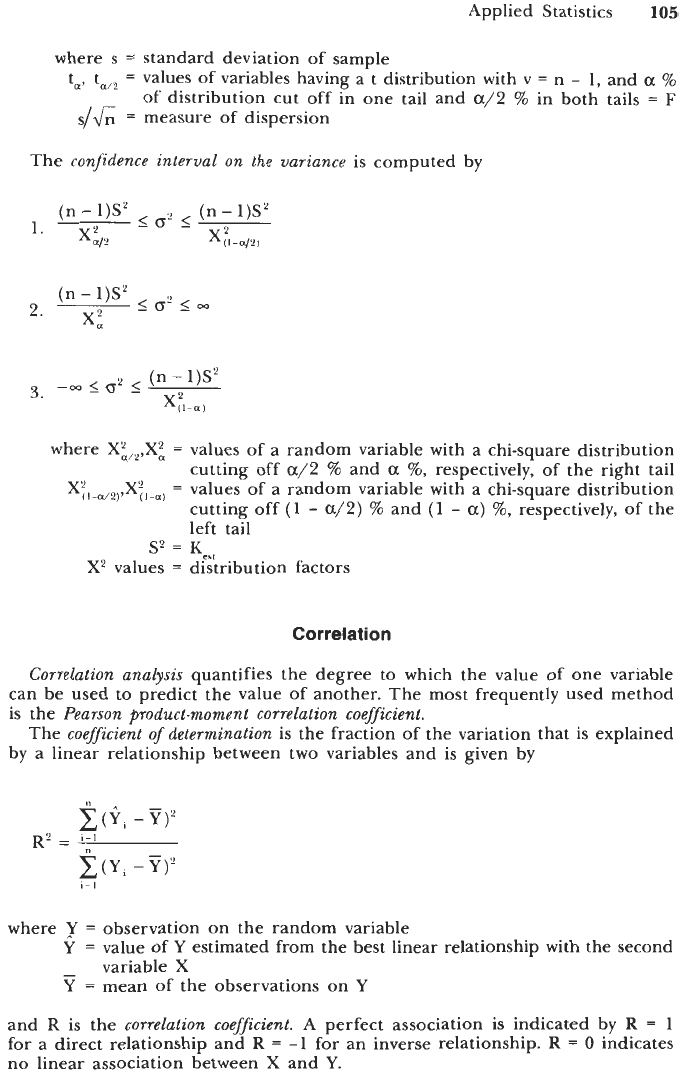
Applied Statistics
105
where
s
=
standard deviation of sample
ta, t,,?
=
values of variables having a
t
distribution with
v
=
n
-
1,
and
a
%
of distribution cut off in one tail and
a/2
%
in both tails
=
F
s/&
=
measure of dispersion
The
confidence interval on the
variance
is
computed by
=
values of a random variable with a chi-square distribution
cutting off
a/2
%
and
a
%,
respectively, of the right tail
=
values of a random variable with a chi-square distribution
cutting off
(1
-
a/2)
%
and
(1
-
a)
%,
respectively, of the
left tail
X2
values
=
distribution factors
S2
=
KCu
Correlation
Correlation analysis
quantifies the degree to which the value of one variable
can be used to predict the value of another. The most frequently used method
is the
Pearson product-moment correlation coefficient.
The
coefficient
of
determination
is the fraction
of
the variation that is explained
by a linear relationship between two variables and is given by
where
Y
=
observation on the random variable
Y
=
value of
Y
estimated from the best linear relationship with the second
y
=
mean of the observations on
Y
variable
X
and
R
is the
correlation coefficient.
A perfect association is indicated by
R
=
1
for a direct relationship and
R
=
-1
for an inverse relationship.
R
=
0
indicates
no linear association between
X
and
Y.
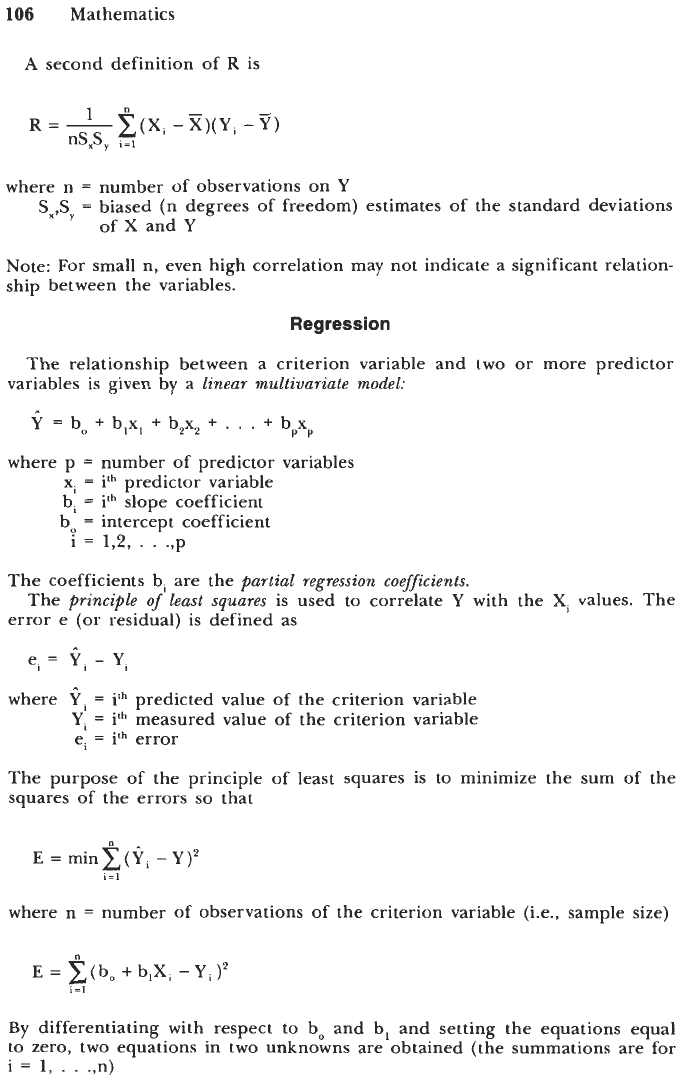
106
Mathematics
A
second definition of
R
is
where n
=
number of observations on
Y
Sx,Sy
=
biased (n degrees of freedom) estimates of the standard deviations
of
X
and
Y
Note: For small n, even high correlation may not indicate a significant relation-
ship between the variables.
Regression
The relationship between a criterion variable and two or more predictor
variables is given by a
linear multivariate model:
Y
=
bo
+
b,x,
+
b,x,
+
. . . +
bpxp
x,
=
ith predictor variable
b,
=
iLh slope coefficient
bo
=
intercept coefficient
where p
=
number of predictor variables
i
=
1,2,
.
.
.,p
The coefficients b, are the
partial regression coefficients.
error e
(or
residual) is defined as
The
principle
of
least squares
is used to correlate
Y
with the XI values. The
e,
=
?,
-
Y,
where
?,
=
ith predicted value of the criterion variable
Y,
=
ith measured value of the criterion variable
error
e
=
ith
The purpose of the principle of least squares is to minimize the sum of the
squares of the errors
so
that
E
=
minf:(qi
-
Y)'
i=l
where n
=
number of observations
of
the criterion variable (i.e., sample size)
E
=
c(b,
+
b,Xi
-Yi)*
i=l
By
differentiating with respect to bo and b, and setting the equations equal
to zero, two equations in two unknowns are obtained (the summations are
for
i
=
1,
. .
.,n)
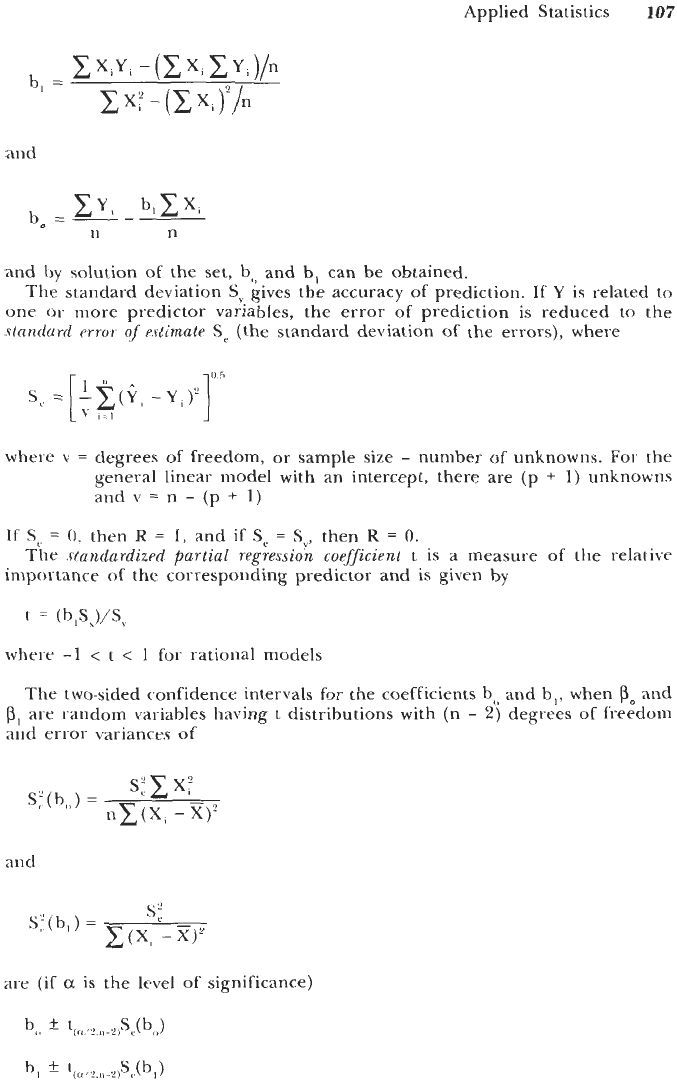
Applied Statistics
107
and
and by solution
of
the set,
b,,
and
b,
can be obtained.
The standard deviation
Sy
gives the accuracy of prediction.
If
Y
is
related
to
one
01-
more predictor variables, the error of prediction is reduced to the
Ftnndurd
crror
of
ertimute
Se
(the standard deviation
of
the errors), where
where
v
=
degrees
of
freedom, or sample size
-
number
of
unknowns. For the
general linear model with an intercept, there are
(p
+
1)
unknowns
and
v
=
n
-
(p
+
1)
If
Sc
=
0,
then
R
=
1,
and if
Se
=
Sv,
then
R
=
0.
importance
of
the corresponding predictor and is given
by
The
sta?adurdized
partial
regresszok
coeffzcient
t
is
a
measure of the relative
t
=
(b,S,)/S,
whei-r
-1
<
t
<
1
for rational models
The two-sided confidence intervals for the coefficients b<, and b,, when
p,
and
PI
are random variables having
t
distributions with (n
-
2)
degrees of freedom
and error variances
of
spcx;
nC(X,
-
X)?
Se(b,,)
=
and
are
(if
a
is
the level of significance)
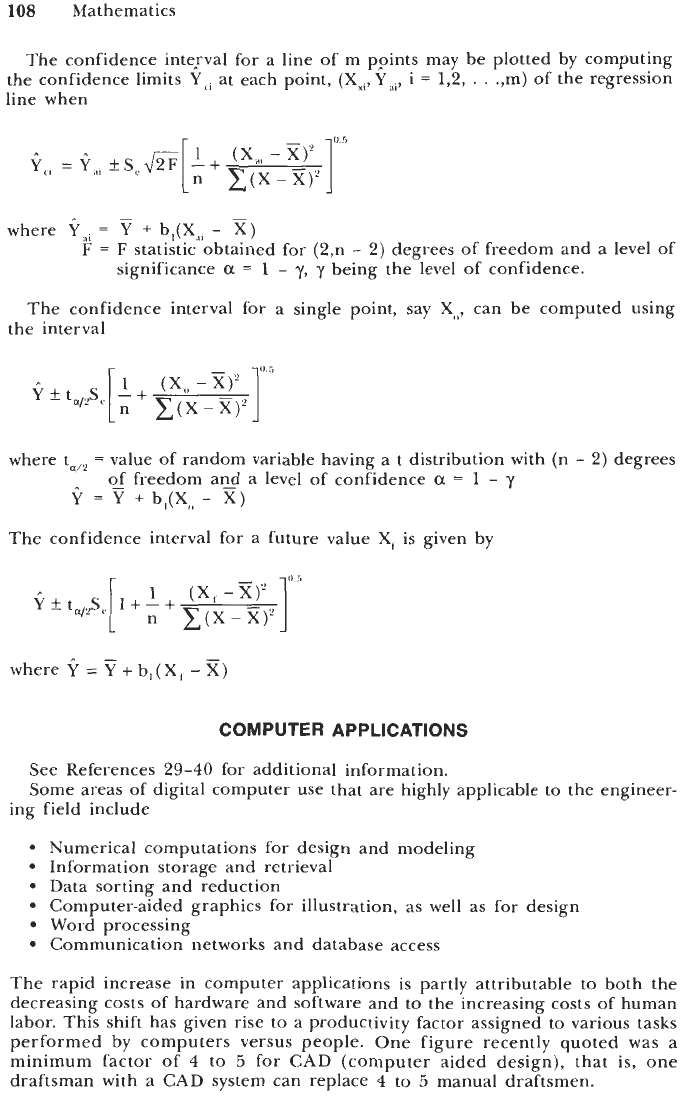
108
Mathematics
The confidence interval for a line
of
m ppints may be plotted by computing
the confidence limits
Ycl
at each point, (Xxt,
Y',,,
i
=
1,2,
. .
.,m) of the regression
line when
-
where
?,,,
=
Y
+
b,(X,x,
-
x)
F
=
F
statistic obtained for (2,n
-
2)
degrees of freedom and a level of
significance
a
=
1
-
y,
y
being the level of confidence.
The confidence interval for a single point, say X<,, can be computed using
the interval
1)
5
1
where t,,
=
value
of
random variable having
a
t
distribution with (n
-
2)
degrees
cf
freedom akd
a
level of confidence
a
=
1
-
y
9
=
Y
+
b,(X<,
-
X)
The confidence interval for
a
future value X, is given by
where +=Y+b,(X,-X)
COMPUTER APPLICATIONS
See References
29-40
for additional information.
Some areas of digital computer use that are highly applicable to the engineer-
ing field include
Numerical computations for design and modeling
Information storage and retrieval
Data sorting and reduction
Computer-aided graphics for illustration, as well as for design
Word processing
Communication networks and database access
The rapid increase in computer applications
is
partly attributable to both the
decreasing costs of hardware and software and to the increasing costs of human
labor. This shift has given rise to a productivity factor assigned to various tasks
performed by computers versus people. One figure recently quoted was a
minimum factor of
4
to
5
for CAD (computer aided design), that is, one
draftsman with
a
CAD system can replace
4
to
5
manual draftsmen.
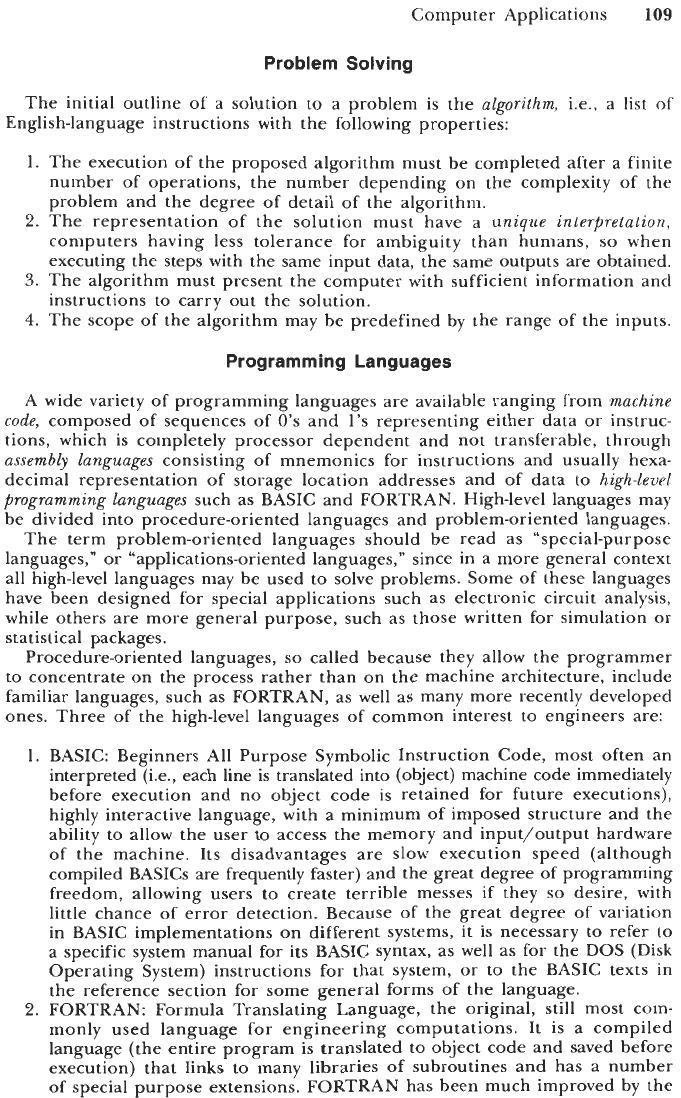
Computer Applications
109
Problem Solving
The initial outline
of
a solution to a problem
is
the
algorithm,
i.e., a
list
of
English-language instructions with the following properties:
1.
The execution of the proposed algorithm must be completed after a finite
number of operations, the number depending on the complexity of the
problem and the degree of detail of the algorithm.
2.
The representation of the solution must have a
unique interpretation,
computers having less tolerance for ambiguity than humans,
so
when
executing the steps with the same input data, the same outputs are obtained.
3.
The algorithm must present the computer with sufficient information and
instructions to carry out the solution.
4.
The scope of the algorithm may be predefined by the range of the inputs.
Programming Languages
A
wide variety of programming languages are available ranging from
machine
code,
composed of sequences of
0’s
and
1’s
representing either data or instruc-
tions, which is completely processor dependent and not transferable, through
assembly languages
consisting of mnemonics for instructions and usually hexa-
decimal representation
of
storage location addresses and of data to
high-level
programming languages
such as BASIC and FORTRAN. High-level languages may
be divided into procedure-oriented languages and problem-oriented languages.
The term problem-oriented languages should be read as “special-purpose
languages,” or “applications-oriented languages,” since in a more general context
all high-level languages may be used to solve problems. Some of these languages
have been designed for special applications such as electronic circuit analysis,
while others are more general purpose, such as those written for simulation or
statistical packages.
Procedure-oriented languages,
so
called because they allow the programmer
to concentrate on the process rather than on the machine architecture, include
familiar languages, such as FORTRAN, as well as many more recently developed
ones. Three of the high-level languages of common interest to engineers are:
1.
BASIC: Beginners All Purpose Symbolic Instruction Code, most often an
interpreted (i.e., each line is translated into (object) machine code immediately
before execution and no object code
is
retained for future executions),
highly interactive language, with a minimum of imposed structure and the
ability to allow the user to access the memory and input/output hardware
of the machine. Its disadvantages are slow execution speed (although
compiled BASICs are frequently faster) and the great degree of programming
freedom, allowing users to create terrible messes
if
they
so
desire, with
little chance of error detection. Because of the great degree of variation
in BASIC implementations on different systems,
it
is necessary to refer to
a specific system manual for its BASIC syntax, as well as for the DOS (Disk
Operating System) instructions for that system, or to the BASIC texts in
the reference section for some general forms of the language.
2.
FORTRAN: Formula Translating Language, the original, still most com-
monly used language for engineering computations. It is a compiled
language (the entire program is translated to object code and saved before
execution) that links to many libraries of subroutines and has a number
of
special purpose extensions. FORTRAN has been much improved by the
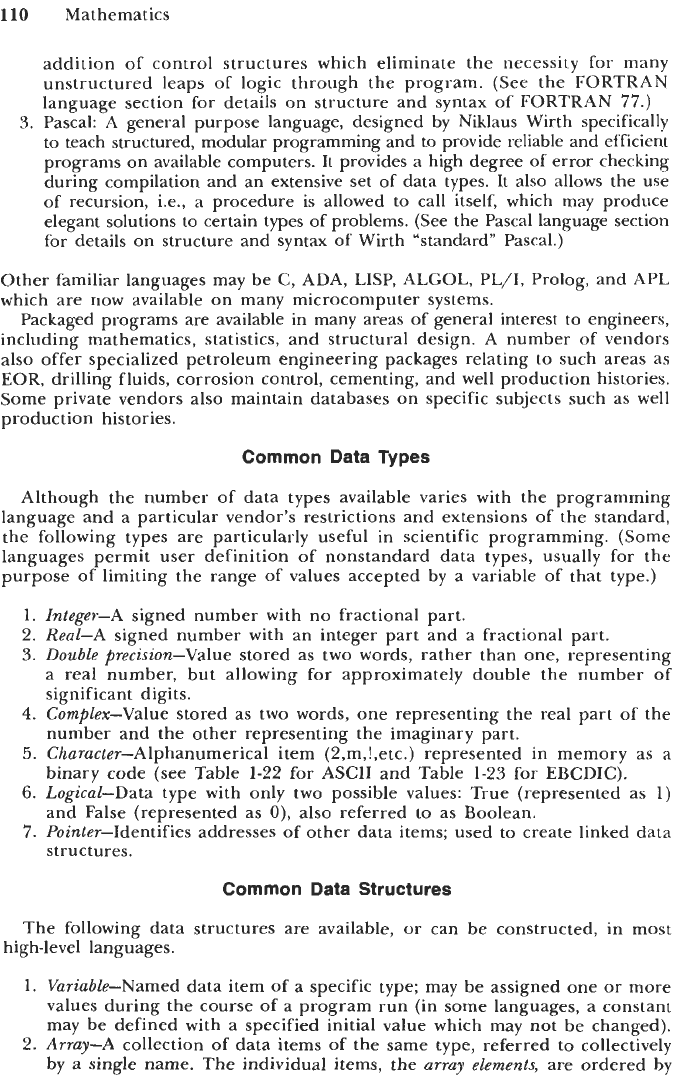
110
Mathematics
addition of control structures which eliminate the necessity for many
unstructured leaps of logic through the program. (See the FORTRAN
language section for details on structure and syntax of FORTRAN
77.)
3.
Pascal:
A
general purpose language, designed by Niklaus Wirth specifically
to teach structured, modular programming and to provide reliable and efficient
programs on available computers. It provides a high degree of error checking
during compilation and an extensive set of data types.
It
also allows the use
of recursion, i.e., a procedure is allowed
to
call itself, which may produce
elegant solutions to certain types of problems. (See the Pascal language section
for details on structure and syntax of Wirth “standard” Pascal.)
Other familiar languages may be
C,
ADA, LISP, ALGOL, PL/I, Prolog, and APL
which are now available on many microcomputer systems.
Packaged programs are available in many areas of general interest
to
engineers,
including mathematics, statistics, and structural design.
A
number of vendors
also offer specialized petroleum engineering packages relating to such areas as
EOR, drilling fluids, corrosion control, cementing, and well production histories.
Some private vendors also maintain databases on specific subjects such as well
production histories.
Common Data Types
Although the number of data types available varies with the programming
language and a particular vendor’s restrictions and extensions of the standard,
the following types are particularly useful in scientific programming. (Some
languages permit user definition of nonstandard data types, usually for the
purpose of limiting the range of values accepted by a variable of that type.)
1.
Integer-A signed number with no fractional part.
2. Real-A signed number with an integer part and a fractional part.
3.
Double precision-Value stored as two words, rather than one, representing
a real number, but allowing for approximately double the number of
significant digits.
4.
Complex-Value stored as two words, one representing the real part of the
number and the other representing the imaginary part.
5.
Character-Alphanumerical item (2,m,!,etc.) represented in memory as a
binary code (see Table 1-22 for ASCII and Table
1-23
for
EBCDIC).
6.
Logical-Data type with only two possible values: True (represented as
1)
and False (represented as
0),
also referred to as Boolean.
7.
Pointer-Identifies addresses of other data items; used to create linked data
structures.
Common Data Structures
The following data structures are available, or can be constructed, in most
high-level languages.
1.
Variable-Named data item of a specific type; may be assigned one or more
values during the course of a program run (in some languages, a constant
may be defined with a specified initial value which may not be changed).
2. Array-A collection of data items of the same type, referred to collectively
by a single name. The individual items, the array elements, are ordered by
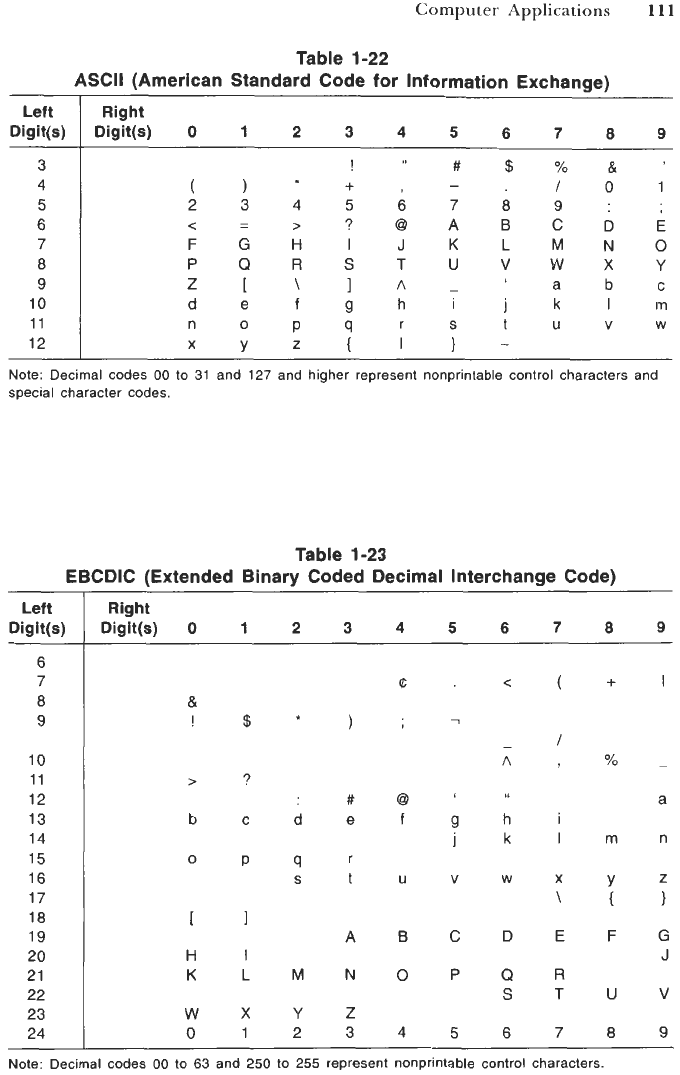
Computer
Applications
11
1
Left
Digit(s)
Right
Digit@)
0
1
2
3
4
5
6
7
8
9
3
4
5
6
7
8
9
10
11
12
Left
Digit@)
!
#$Yo&'
o*+
-
to1
23456789:
-
>?@ABCDE
FGHIJKLMNO
PQRSTUVWXY
z[\IA-
'abc
defgh
I
ik
Im
nopqr
S
t
U
XYZ(l1-
<
-
vw
Right
Digit(s)
0
1
2
3
4
5
6
7 8
9
Note: Decimal codes
00
to 31 and 127 and higher represent nonprintable control characters and
special character codes.
10
11
12
13
14
15
16
>?
bcdefgh
i
opqr
#@'
a
jklmn
S
tuvwxyz
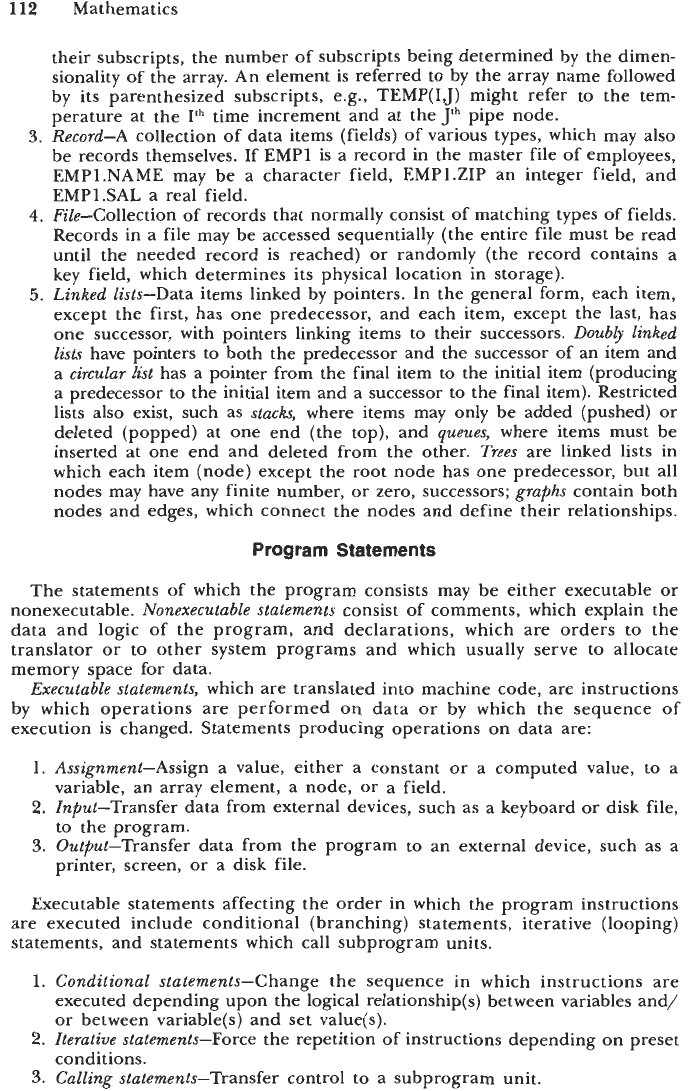
112
Mathematics
their subscripts, the number of subscripts being determined by the dimen-
sionality of the array. An element is referred to by the array name followed
by its parenthesized subscripts, e.g., TEMP(
IJ)
might refer to the tem-
perature at the Ith time increment and at the
Jh
pipe node.
3.
Record-A collection of data items (fields) of various types, which may also
be records themselves. If EMPl is a record in the master file of employees,
EMP1.NAME may be a character field, EMPl.ZIP an integer field, and
EMPlSAL a real field.
4.
File-Collection of records that normally consist of matching types of fields.
Records in a file may be accessed sequentially (the entire file must be read
until the needed record is reached) or randomly (the record contains a
key field, which determines its physical location in storage).
5.
Linked lists-Data items linked by pointers. In the general form, each item,
except the first, has one predecessor, and each item, except the last, has
one successor, with pointers linking items to their successors. Doubly linked
lists have pointers to both the predecessor and the successor
of
an item and
a circular list has a pointer from the final item
to
the initial item (producing
a predecessor to the initial item and a successor to the final item). Restricted
lists also exist, such as stacks, where items may only be added (pushed) or
deleted (popped) at one end (the top), and queues, where items must be
inserted at one end and deleted from the other. Trees are linked lists in
which each item (node) except the root node has one predecessor, but all
nodes may have any finite number, or zero, successors; graphs contain both
nodes and edges, which connect the nodes and define their relationships.
Program Statements
The statements of which the program consists may be either executable or
nonexecutable. Nonexecutable statements consist of comments, which explain the
data and logic of the program, and declarations, which are orders to the
translator or to other system programs and which usually serve to allocate
memory space for data.
Executable statements, which are translated into machine code, are instructions
by which operations are performed on data or by which the sequence of
execution
is
changed. Statements producing operations on data are:
1.
Assignment-Assign a value, either a constant or a computed value, to a
2.
Input-Transfer data from external devices, such as a keyboard or disk file,
3.
Output-Transfer data from the program
to
an external device, such as a
variable, an array element, a node, or a field.
to the program.
printer, screen, or a disk file.
Executable statements affecting the order in which the program instructions
are executed include conditional (branching) statements, iterative (looping)
statements, and statements which call subprogram units.
1.
Conditional statements-Change the sequence in which instructions are
executed depending upon the logical relationship(
s)
between variables and/
or between variable(s) and set value(s).
2.
Iterative statements-Force the repetition of instructions depending on preset
conditions.
3.
Calling statements-Transfer control to a subprogram unit,
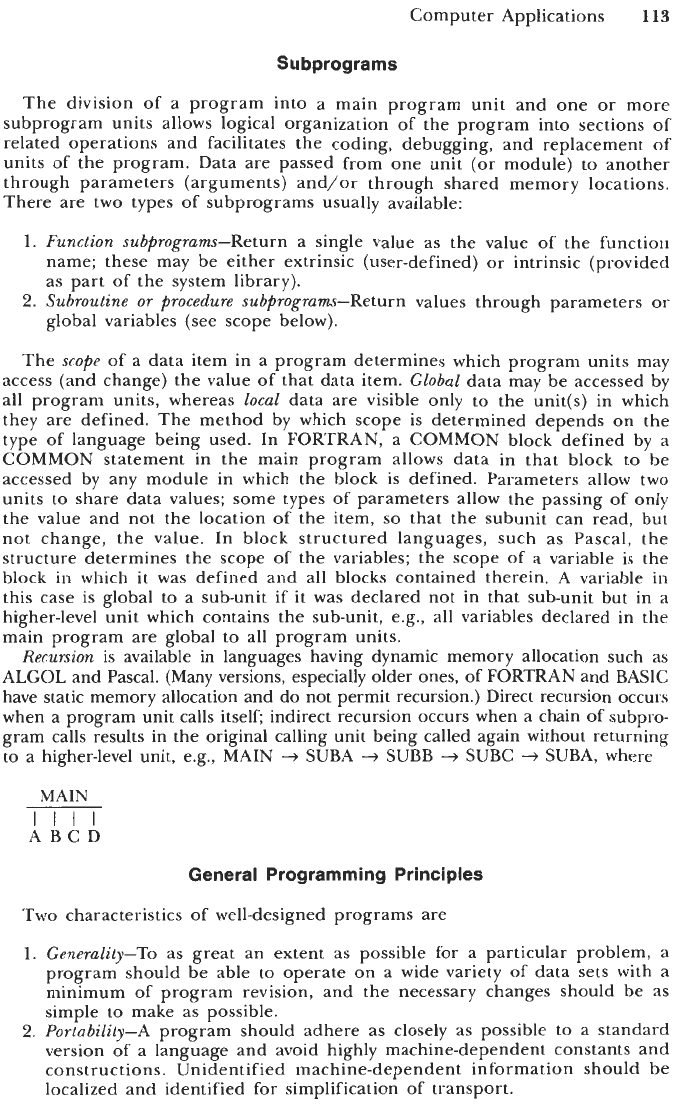
Computer Applications
113
Subprograms
The division of a program into a main program unit and one or more
subprogram units allows logical organization of the program into sections of
related operations and facilitates the coding, debugging, and replacement of
units of the program. Data are passed from one unit (or module) to another
through parameters (arguments) and/or through shared memory locations.
There are two types of subprograms usually available:
1.
Function subprograms-Return a single value as the value
of
the function
name; these may be either extrinsic (user-defined) or intrinsic (provided
as part of the system library).
2.
Subroutine
or
procedure subprograms-Return values through parameters or
global variables (see scope below).
The scope of a data item in a program determines which program units may
access (and change) the value of that data item. Global data may be accessed by
all program units, whereas local data are visible only to the unit(s) in which
they are defined. The method by which scope is determined depends on the
type of language being used. In FORTRAN, a COMMON block defined by a
COMMON statement in the main program allows data in that block to be
accessed by any module in which the block is defined. Parameters allow two
units to share data values; some types of parameters allow the passing of only
the value and not the location of the item,
so
that the subunit can read, but
not change, the value. In block structured languages, such as Pascal, the
structure determines the scope of the variables; the scope of a variable
is
the
block in which
it
was defined and all blocks contained therein. A variable in
this case is global to a sub-unit if
it
was declared not in that sub-unit but in a
higher-level unit which contains the sub-unit, e.g., all variables declared in the
main program are global to all program units.
Recursion is available in languages having dynamic memory allocation such as
ALGOL and Pascal. (Many versions, especially older ones, of FORTRAN and BASIC
have static memory allocation and do not permit recursion.) Direct recursion occurs
when a program unit calls itself; indirect recursion occurs when a chain of subpro-
gram calls results in the original calling unit being called again without returning
to a higher-level unit, e.g., MAIN
+
SUBA
+
SUBB
+
SUBC
-+
SUBA, where
MAIN
IIII
ABCD
General Programming Principles
Two characteristics of well-designed programs are
1.
Generality-To as great an extent as possible for a particular problem, a
program should be able to operate on a wide variety of data sets with a
minimum of program revision, and the necessary changes should be as
simple to make as possible.
2.
Portability-A program should adhere as closely as possible to a standard
version of a language and avoid highly machine-dependent constants and
constructions. Unidentified machine-dependent information should be
localized and identified for simplification of transport.
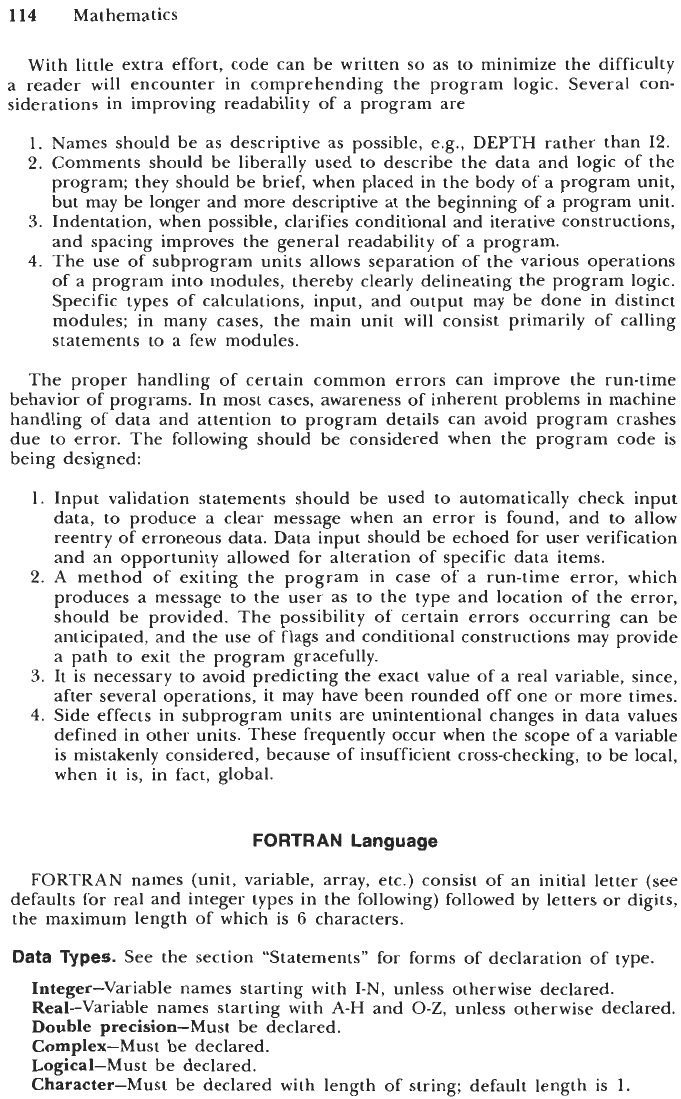
114 Mathematics
With little extra effort, code can be written
so
as to minimize the difficulty
a reader will encounter in comprehending the program logic. Several con-
siderations in improving readability of a program are
1.
Names should be as descriptive as possible, e.g., DEPTH rather than 12.
2. Comments should be liberally used to describe the data and logic of the
program; they should be brief, when placed in the body of a program unit,
but may be longer and more descriptive at the beginning of a program unit.
3.
Indentation, when possible, clarifies conditional and iterative constructions,
and spacing improves the general readability of a program.
4.
The use of subprogram units allows separation of the various operations
of a program into modules, thereby clearly delineating the program logic.
Specific types of calculations, input, and output may be done in distinct
modules; in many cases, the main unit
will
consist primarily of calling
statements to a few modules.
The proper handling of certain common errors can improve the run-time
behavior of programs. In most cases, awareness of inherent problems in machine
handling
of
data and attention to program details can avoid program crashes
due to error. The following should be considered when the program code is
being designed:
1.
Input validation statements should be used
to
automatically check input
data, to produce a clear message when an error is found, and to allow
reentry of erroneous data. Data input should be echoed for user verification
and an opportunity allowed for alteration of specific data items.
2.
A method
of
exiting the program in case of a run-time error, which
produces a message to the user as to the type and location of the error,
should be provided. The possibility
of
certain errors occurring can be
anticipated, and the use of flags and conditional constructions may provide
a path to exit the program gracefully.
3.
It is necessary to avoid predicting the exact value of a real variable, since,
after several operations,
it
may have been rounded off one or more times.
4.
Side effects in subprogram units are unintentional changes in data values
defined in other units. These frequently occur when the scope of a variable
is mistakenly considered, because of insufficient cross-checking, to be local,
when
it
is, in fact, global.
FORTRAN
Language
FORTRAN names (unit, variable, array, etc.) consist
of
an initial letter (see
defaults for real and integer types in the following) followed by letters or digits,
the maximum length of which is 6 characters.
Data
Types.
See the section “Statements” for forms of declaration of type.
Integer-Variable names starting with
I-N,
unless otherwise declared.
Real-Variable names starting with A-H and
0-Z,
unless otherwise declared.
Double precision-Must be declared.
Complex-Must be declared.
Logical-Must be declared.
Character-Must be declared with length of string; default length is
1.
